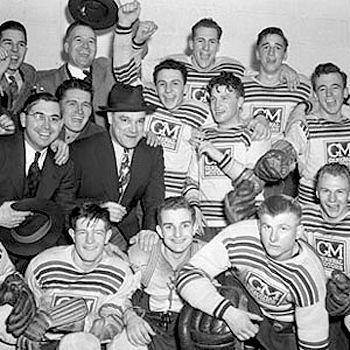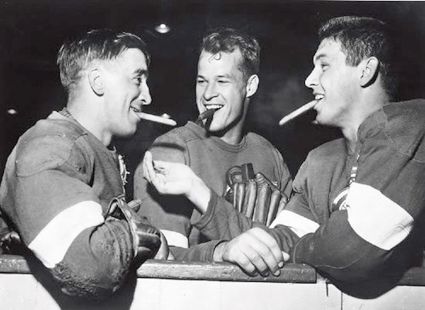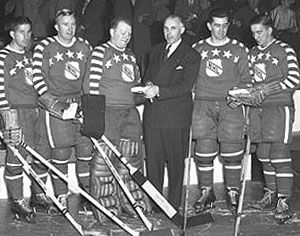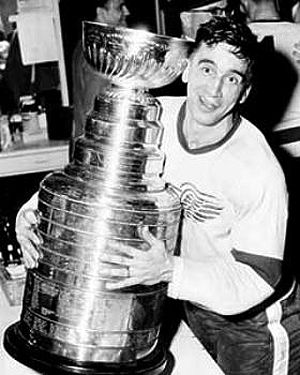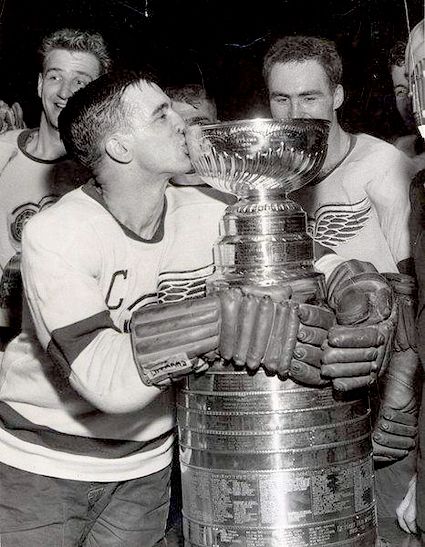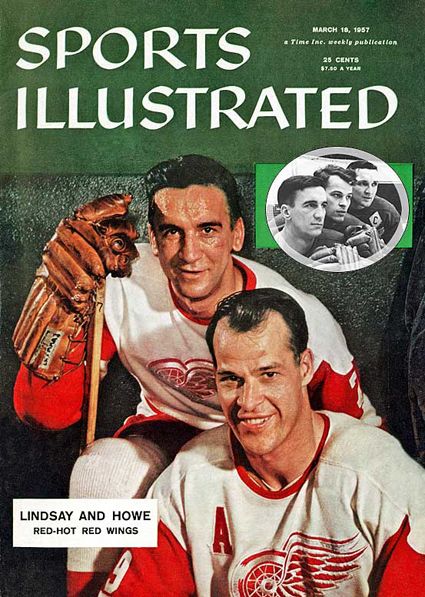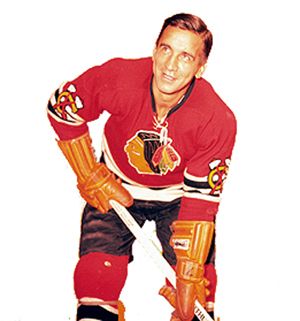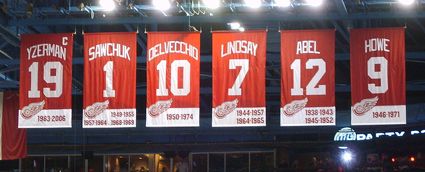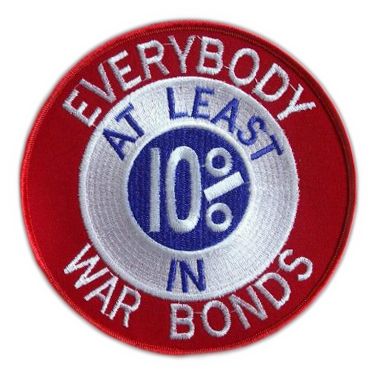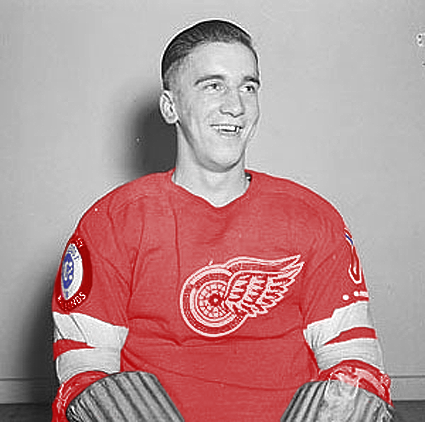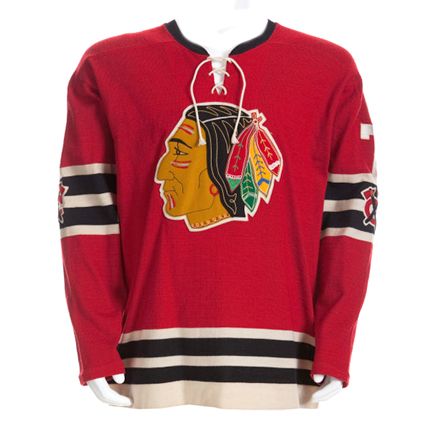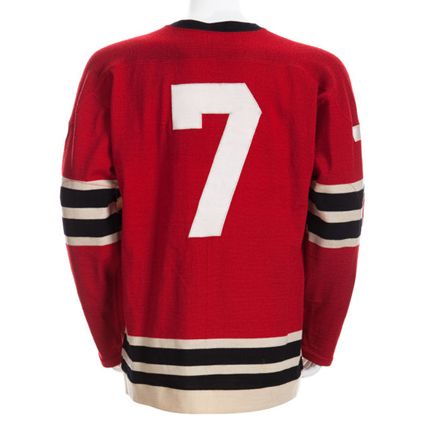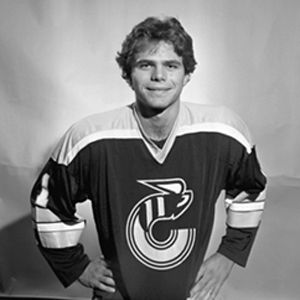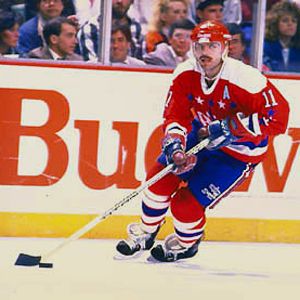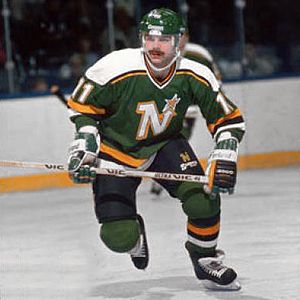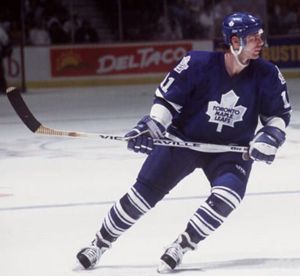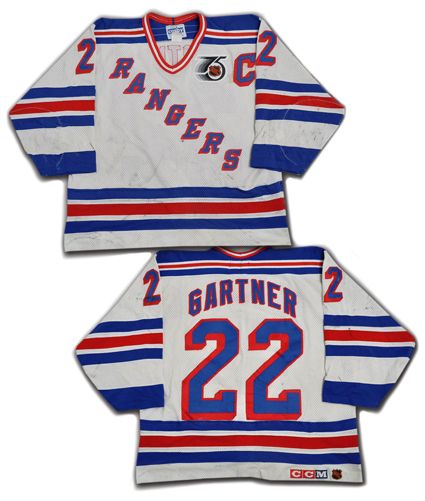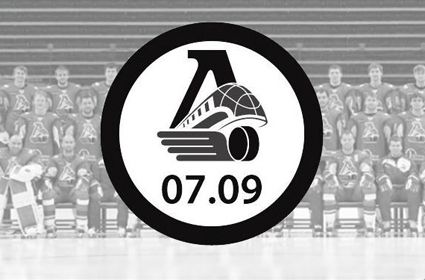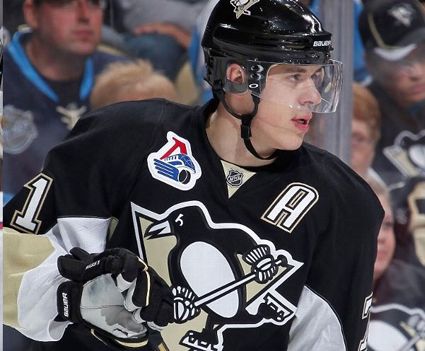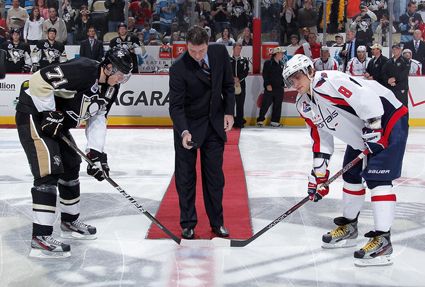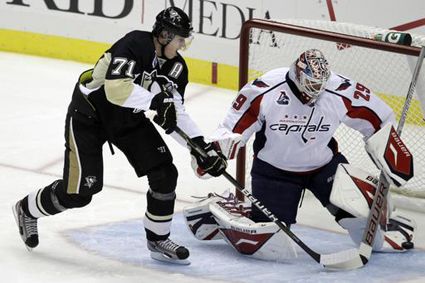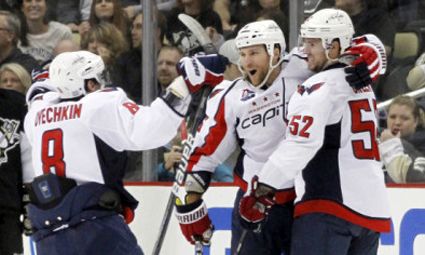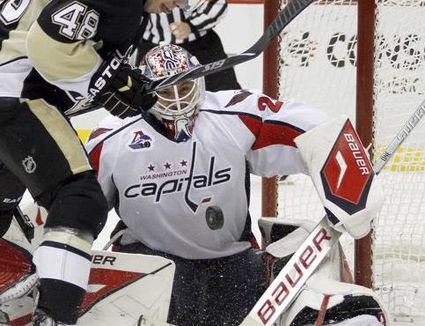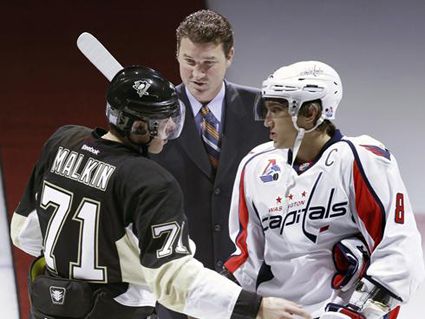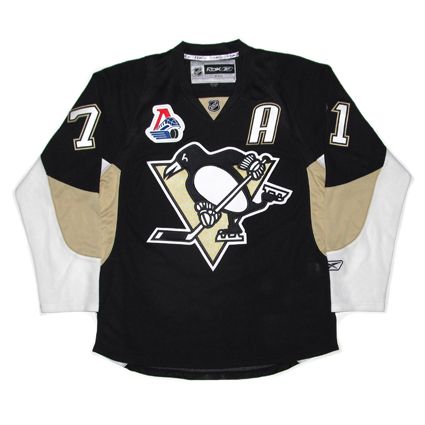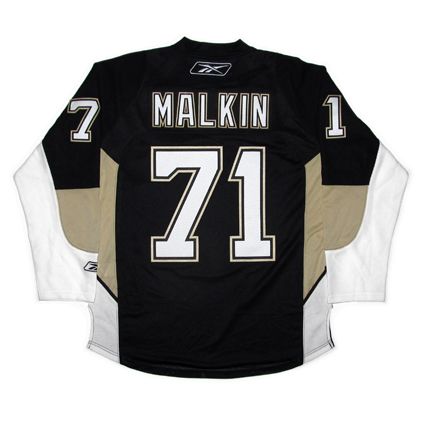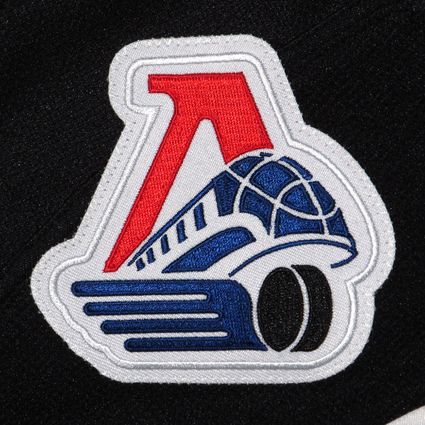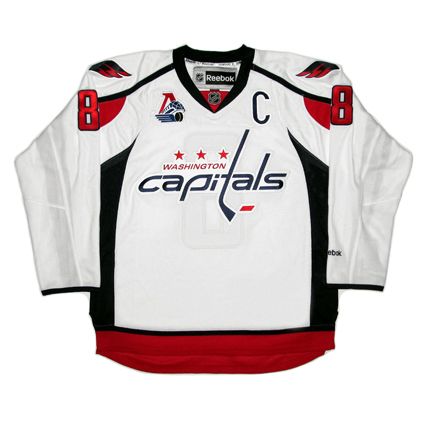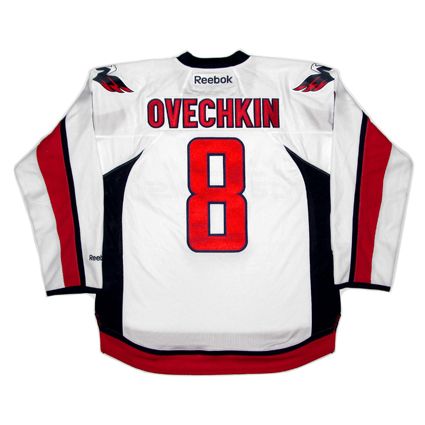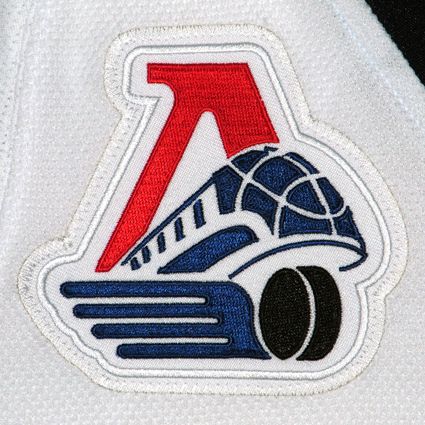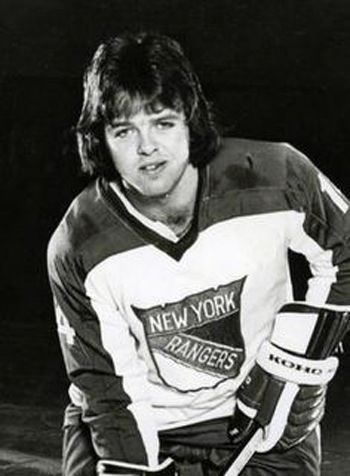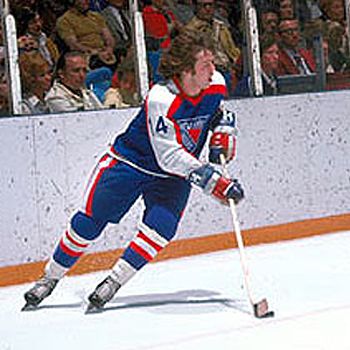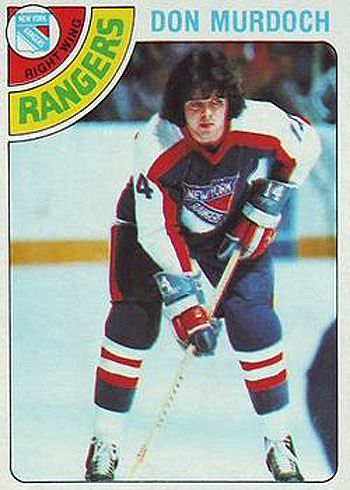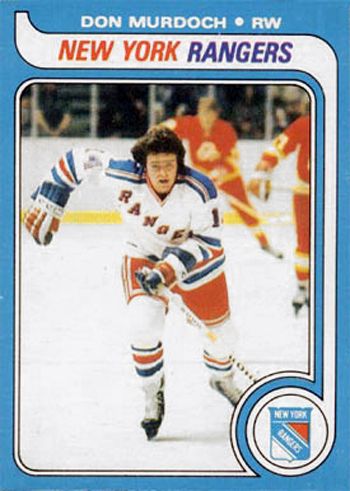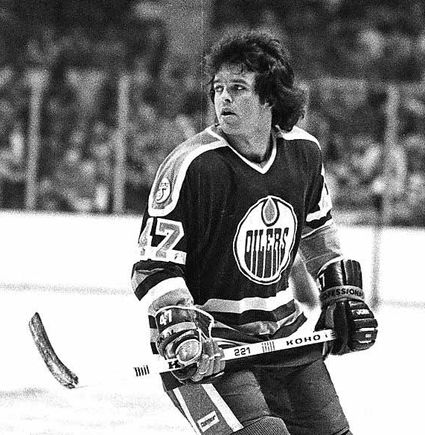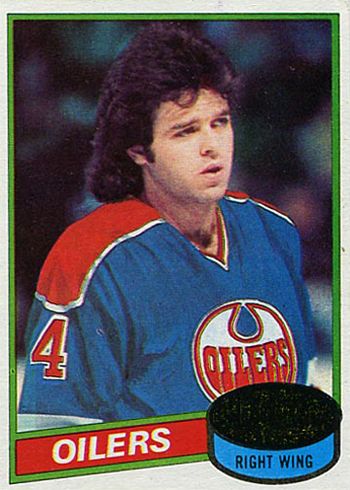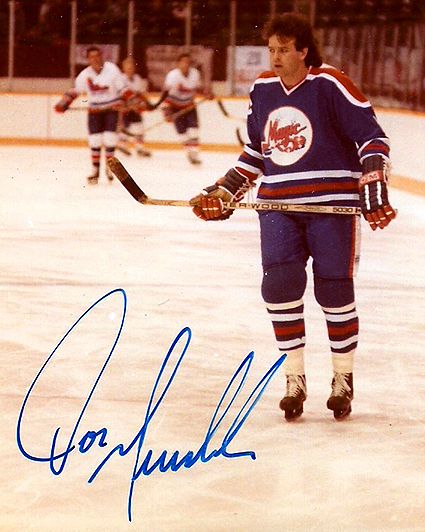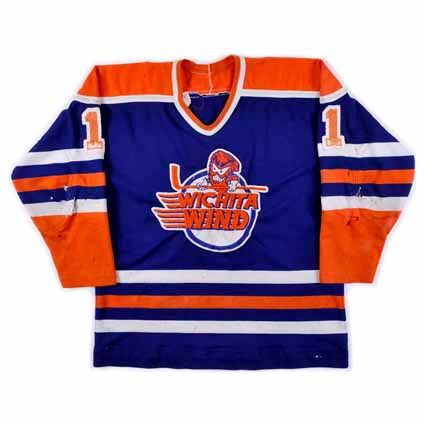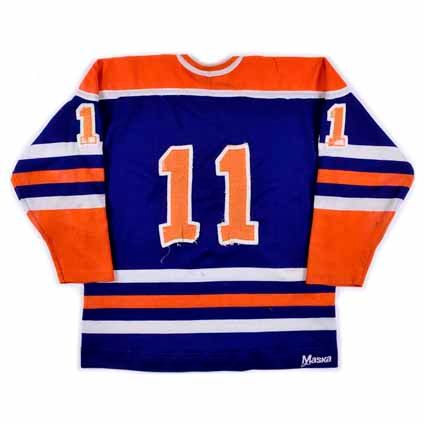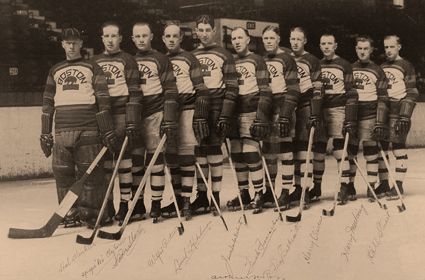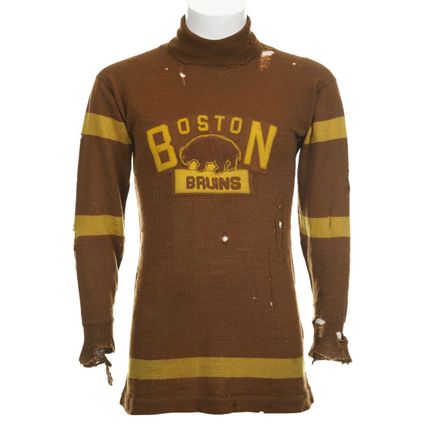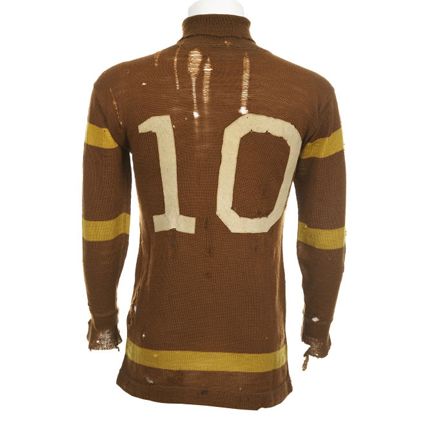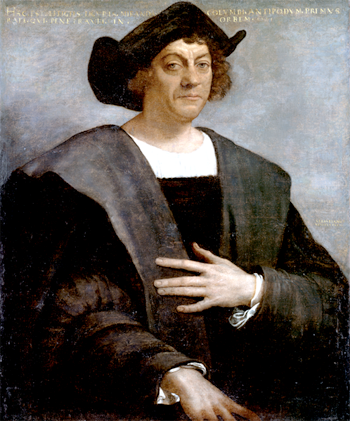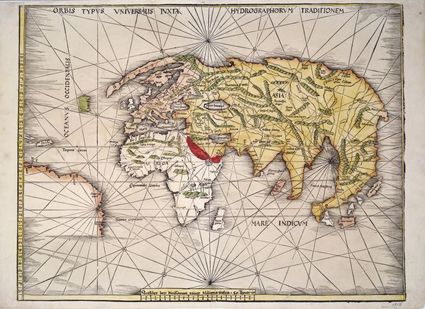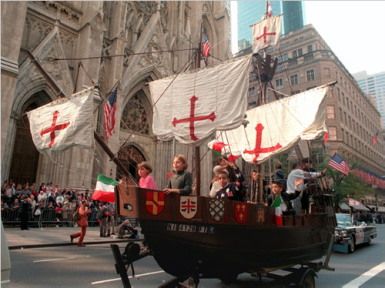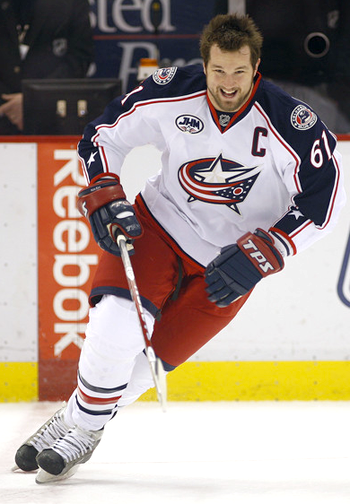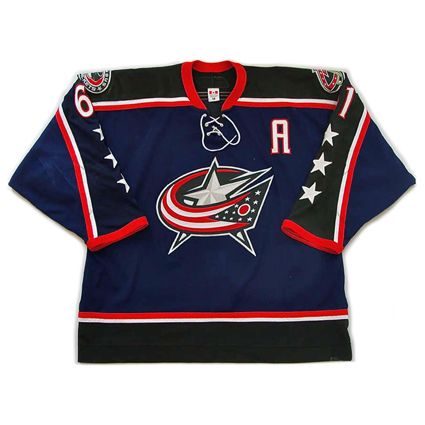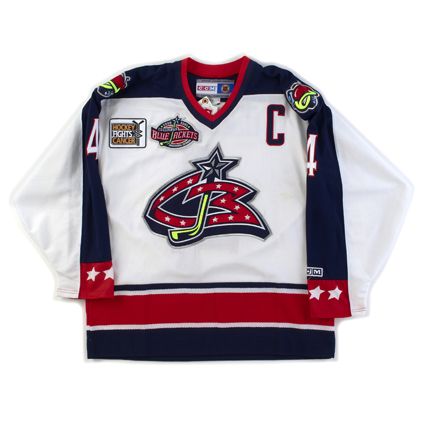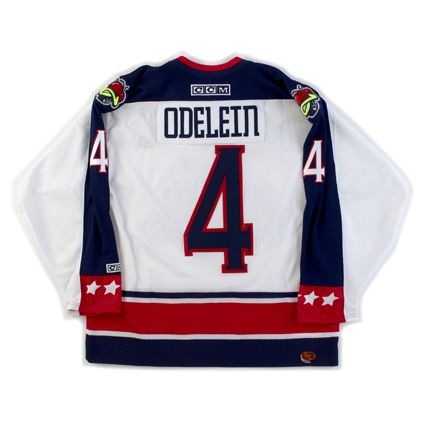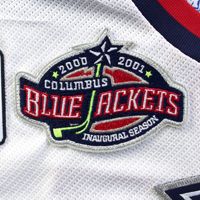In 1991, the Detroit Red Wings held a pregame ceremony where they retired Lindsay's #7 sweater as well as the #10 of Alex Delvecchio.
Saturday, October 15, 2016
1944-45 Detroit Red Wings Ted Lindsay Jersey
After growing up the son of a goaltender who once played for the storied, turn of the century Renfrew Millionaires, Ted Lindsay played junior hockey for the St. Michael's Majors before joining the Oshawa Generals in time to win the 1944 Memorial Cup.
In 2010 the NHL Players Association renamed the award the players vote on for their annual MVP from the Lester Pearson Award to the Ted Lindsay Award in honor of his pioneering work in forming the player's association.
Ted Lindsay and the 1944 Memorial Cup champion Oshawa Generals
Lindsay joined the Detroit Red Wings for 1944-45 and had a couple of average seasons to begin his career, 23 points and then just 17 in 1945-46, but then the following year Lindsay was put on a line with veteran Sid Abel and a rookie named Gordie Howe and his career shifted into high gear.
The line was dubbed "The Production Line" based on their offensive output, which saw Lindsay's point totals jump from 17 to 42 and then continue to rise to 52 to lead the Red Wings in scoring and the entire league in goals with 33.
His point total rose to 54 in 1948-49 before a quantum leap to 78 points in 1949-50 to win the Art Ross Trophy for leading the entire NHL in scoring as Howe and Abel came in second and third, giving the line a 1-2-3 standing in the scoring race. "Terrible Ted" also was third in the league with 141 penalty minutes, just three back of the league leader.
Lindsay being named a first team All-Star in 1948
Note the unusual treatment of the assistant captain's "A" contained in the diamond shape
In the playoffs, the Red Wings outlasted the Toronto Maple Leafs in seven games and then duplicated the feat against the New York Rangers to win the first Stanley Cup of Lindsay's career. In both series Detroit won Game 7 in overtime.
Lindsay celebrates with the Stanley Cup
The Red Wings would again capture the Stanley Cup two seasons later in 1951-52 after Lindsay had the second 30 goal season of his career. In 1952-53, he would again top 30 goals with 32 and 70 points for the second time with 71. After the departure of Abel, Lindsay was named captain of the Red Wings, a position he would hold until 1956. It was during this time period that Lindsay began the tradition of the captain of the winning team lifting the Stanley Cup and skating it around the ice in celebration, a scene now repeated every year.
Captain Lindsay with the 1954 Stanley Cup
The 19954-55 Red Wings would finished first overall in the league for the seventh consecutive season and go on to take the fourth Stanley Cup of Lindsay's career. While he was limited to just 49 games of the regular season in 1954-55, snapping his 20 goals/40 points streak at 8 seasons, he was healthy in time for the playoffs where his stellar 19 points in 11 games contributed greatly to Detroit winning the second of back-to-back championships.
The time he missed also interrupted his consecutive streak of 100 penalty minutes or more streak, the only one of ten seasons he was under the century mark. So rough was Lindsay's style of play that penalties had to be created for elbowing and kneeing! He also acquired more than 400 stitches during his career before losing track.
in 1956-57, Lindsay had the greatest offensive season of his career with 85 points, this coming from 30 goals and a league leading 55 assists, which earned him a Sports Illustrated cover.
Lindsay and Howe on the Cover of SI in the spring of 1957
He was also busy that season off the ice, organizing the NHL Players' Association. Already not on good terms with Detroit general manager Jack Adams, Lindsay's union organizing efforts saw him stripped of his captaincy and later earned him a trip out of town, as he was banished to the lowly Chicago Black Hawks, who had missed the playoffs 12 times in the previous 14 seasons, in a six team league no less! Lindsay was the NHL's third leading all-time goal scorer at the time of the trade.
While the Black Hawks would miss the playoffs in 1957-58, Lindsay would have by far his best of three seasons in Chicago in 1958-59 with 22 goals and 58 points as well as a career high of 184 penalty minutes as the Black Hawks returned to the playoffs for the first time in six seasons. He would retire after one more season with Chicago with 999 games played.
Lindsay while with the Black Hawks
After four seasons away from the ice, Adams replacement and old line mate Abel coaxed Lindsay out of retirement for the 1964-65 season. He returned to the ice on this date in 1964 for his 1,000th NHL game, becoming only the fourth player in league history at the time to have reached 1,000 games after linemate Howe, Bill Gadsby and Red Kelly. Lindsay added a final 14 goals and 28 points to his career totals as the Red Wings finished with the best regular season record in the league for the first time since his departure.
His final career totals are 379 goals and 472 assists for 851 points in 1,068 games played along with 1,808 penalty minutes. He also competed in 133 playoff games (in an era when the maximum number of games was just 14) scoring 47 goals and 49 assists for 96 points. At the time of his retirement, Lindsay was the highest scoring left winger in league history.
He played in 11 NHL All-Star Games and won four Stanley Cups and was inducted into the Hockey Hall of Fame in 1966, but declined to attend the ceremony since it was for men only, and he wanted his wife and family to attend, a rule which was changed for the following year.
In 1991, the Detroit Red Wings held a pregame ceremony where they retired Lindsay's #7 sweater as well as the #10 of Alex Delvecchio.
In 1991, the Detroit Red Wings held a pregame ceremony where they retired Lindsay's #7 sweater as well as the #10 of Alex Delvecchio.
Lindsay's #7 hangs in the rafters of Joe Louis Arena with the other Red Wings honored greats
Today's featured jersey is a 1944-45 Detroit Red Wings Ted Lindsay jersey. While the Red Wings jerseys have remained essential unchanged since the dawn of time, this particular one stands out for the patches worn on the sleeves during Lindsay's rookie season in the NHL.
The patch on Lindsay's left sleeve is a "V" for victory, with three dots on the left of the patch and a dash on the right (Morse code for "v") was first worn during the 1941-42 season. It remained for four seasons through 1944-45.
On Lindsay's right sleeve is a patch promoting the purchase of war bonds. First worn in 1942-43, this patch was used for three seasons through 1944-45.
After wearing a patch during 1951 to promote the 250th anniversary of the City of Detroit, the Red Wings would not wear another patch until 1975 for the franchise's 50th Anniversary.
Bonus Jersey: Today's bonus jersey is a 1958-59 Chicago Black Hawks Ted Lindsay jersey. While very similar to today's Blackhawks jerseys, note the location of the crossed tomahawks inside the sleeve stripes rather than the now traditional placement on the shoulders.
This beautiful old sweater shows just why the Black Hawks jerseys frequently finish at the top of lists of best jerseys and was worn by Lindsay during the 1959 playoffs.
Today's video section begins with Ted Lindsay's biography from the Legends of Hockey series.
In this next clip, a look back at Ted Lindsay's career first broadcast in 1978 when Lindsay was the general manager of the Red Wings.
Labels:
Chicago Blackhawks,
Detroit Red Wings,
Lindsay Ted
Friday, October 14, 2016
1991-92 New York Rangers Mike Gartner Jersey
Mike Gartner started his pro career with the Cincinnati Stingers of the World Hockey Association, having just turned 19 years old, below the NHL minimum age of 20 at the time.
His 27 goals and 52 points that season for the Stingers got the attention of the general mangers in the NHL, and Gartner was drafted 4th overall by the Washington Captials in the summer of 1979 following the demise of the Stingers as well as the WHA.
As a rookie with the Capitals, Gartner scored 36 goals, beginning a streak of 30 goals or more seasons that would eventually reach into the mid 90's.
In ten seasons with the Capitals, Gartner would average 39.7 goals per season and never less than 35 until the 1988-89 season when he was traded to the Minnesota North Stars 56 games into the season while currently at 26 goals. He would, however, score an additional seven goals in Minnesota to keep his streak going at ten seasons.
After enjoying so much stability in Washington, Gartner's time in Minnesota would be brief, as he was dealt to the New York Rangers after 67 games in 1989-90, but not before scoring 34 goals with the North Stars. After joining the Rangers, he would add 11 more to his season total which allowed him to reach the 40 goal mark for the sixth time.
Three consecutive 40 goal seasons in Manhattan followed, which included scoring his 500th NHL goal on this date in 1991. He would later surpass the 600 goal barrier as well as 1,000 points, prior to Gartner once more being on the move, this time to his hometown Toronto Maple Leafs. His 28 goals in 71 games in New York and the six he scored in 10 games with the Maple Leafs pushed his 30 goal streak to an NHL record 15 consecutive seasons.
The strike shortened season of 1994-95 only allowed Gartner to play in 38 games, limiting him to just 12 goals and unfairly ending his streak of 30 goal seasons at 15.
Back to a full season schedule in 1995-96, Gartner would run his 30 goal season total up to 16 with 35 goals. The Maple Leafs would trade Gartner to the Phoenix Coyotes in time for their first season in the desert, having just relocated from Winnipeg. There, Gartner would achieve his 17th season of 30 goals or more in his career, also a league record, when he scored twice on this date in 1997 in a 5-0 win over the Tampa Bay Lightning. His second goal of the night was also the 1,300th point in his NHL career.
Gartner would play one final season in the NHL with Phoenix. He would play in 60 games and score 12 goals, which included his 700th career goal, only the fifth player to ever reach that mark.
His final career totals are 708 goals, good for sixth all time, and 627 assists for 1,335 points.
While Gartner set records for his consistent goal scoring, he was probably better known for his speed, winning the always popular and high profile "Fastest Skater Competition" at the NHL All-Star Game each of the three times he entered, including 1993 when he scored four goals and was named the MVP of the All-Star Game.
During his career he would play in seven NHL All-Star Games and following his career he was inducted into the Hockey Hall of Fame in 2001 and his #11 was retired by the Capitals in 2008.
Today's featured jersey is a 1991-92 New York Rangers Mike Gartner jersey which features NHL 75th Anniversary patch on the upper left chest, while every other club, save the Philadelphia Flyers, wore the patch on their upper right chest. Having a unique patch placement when compared to other clubs is a common occurrence for the Rangers, due to the "R" of the diagonal Rangers cresting on their jerseys occupying the traditional location for patches. In general, the Rangers place additional patches on their right shoulder, but have used the left shoulder on occasion as well, as was the case with the 9/11 memorial ribbon patch.
Patches worn on the right shoulder include the Stanley Cup 100th Anniversary, the 1994 NHL All-Star Game, 1994 Stanley Cup Finals, the Rangers 75th and 85th Anniversary patches.
The only time the Rangers were able to join the flock was in 1999-00 when the NHL 2000 patch was a horizontal design, short enough to fit above the "R" in the space remaining.
Here is a great career retrospective of Mike Gartner's career on the occasion of his induction into the Hockey Hall of Fame, followed by his speech. The audio is a tad bit distorted, but still listenable.
Labels:
Gartner Mike,
New York Rangers
Thursday, October 13, 2016
2011-12 Pittsburgh Penguins Evgeni Malkin "Lokomotiv" Jersey
On this date in 2011, the Pittsburgh Penguins and Washington Capitals, led by two of the most prominent Russian stars in the NHL, Evgeni Malkin of Pittsburgh and Alexander Ovechkin of Washington, combined in a joint effort to raise funds to benefit the families of the victims of the Yaroslavl Lokomotiv disaster, the tragic plane crash on September 7, 2011 which claimed the lives of the entire Lokomotiv roster of 26 players and 11 members of the team's coaches staff as they were on their way to their opening game of the season.
The idea for the effort originated with Malkin, as Penguins Head Coach Dan Bylsma recounted that Malkin doesn't ask for meetings with him and Penguins General Manager Ray Shero much, but "right away, he's like, "We wanted to do something" - not only for this game but for the families, for the team, for his loss, for the country's loss, for hockey's loss."
The desire to do honor the victims and support their survivors led to both teams wearing a Lokomotiv patch for their first meeting of the season, with the jerseys then signed and auctioned off following the game.
Penguins owner Mario Lemieux was on hand to drop the puck for the ceremonial faceoff between fellow Russians Malkin and Ovechkin.
"It's kind of remembering the people who died. Trying to help in any way we can," said Capitals goaltender Tomas Vokoun. "This is not going to be fixed. It's impossible. But we can just try to make it a little bit easier for everybody involved."
Malkin related, "We're one big hockey family and we need help because of the crash in Russia."
Many of the players and staff of the Penguins and Capitals knew or had played with many members of not only the Lokomotiv team, but it's coaching staff as well, as several of them were NHL veterans themselves. While Yaroslavl was a Russian team, it's roster consisted of players from Belarus, the Czech Republic, Germany, Latvia, Slovakia, Sweden, Russia and Ukraine and the team staff originated from Belarus, Canada and Russia.
"Our hockey families have been touched and you see that response in a lot of different ways," said Bylsma.
Capitals coach Bruce Boudreau said the cooperation between the two rival clubs shows what "brotherhood" in hockey is all about and "hopefully they raise a ton of money to help the families of everybody that's been affected by this. It's a terrible disaster and the one great thing about the hockey world is it's one big family when it comes down to it, whether is the Kontinental Hockey League or the NHL. Our guys can help their guys, and I think it's great."
"I think it's America showing respect, respecting the memories of the guys who were in the plane crash and for Russians, " Ovechkin said. "It means a lot. It's nice of both organizations and the NHL to do that."
During the game, James Neal opened the scoring at 12:27 with assists from Steve Sullivan and Malkin, who was playing his first game back after missing the two previous games due to soreness in his surgically repaired right knee.
Mike Knuble tied it for Washington just 1:20 into the second, assisted by Russian Alexander Semin and Karl Alzner.
Ovechkin's first goal of the season a mere 40 seconds into the third period, from Mike Green and Nicklas Backstrom put the Capitals back on top before Neal's second goal of the game, assisted again by Malkin as well as Chris Kunitz at 16:15 tied the game once again. Neal was quoted after the game as saying "Geno was really flying tonight."
When regulation ended deadlocked at 2-2, the game moved to overtime, and with Jordan Staal of Pittsburgh in the penalty box for tripping Ovechkin, Capitals defenseman Dennis Wideman won the game for Washington with the lone assist going to Backstrom 44 seconds into the power play at 2:48.
Vokoun got the win in goal for Washington after making 39 saves on 41 shots, while Brent Johnson took the loss for the Penguins, recording just 16 saves on the 19 Capitals shots.
The final jersey auction results saw the Capitals captain Ovechkin's jersey going for the most at $5501, with the Penguins captain Sidney Crosby's jersey going for $4097 (despite his not playing in the game due to still recovering from the concussion he suffered in the 2011 Winter Classic against the Capitals ten months earlier) and Malkin's assistant captain's jersey next at $4020.
"The teams' tribute to the Yaroslavl hockey club is testament to the remarkable bonds shared by all members of the global hockey family," KHL President Alexander Medvedev said. "As we see tonight, great sports rivalries can be put aside when there is an opportunity to benefit those who are in need."
Today's featured jersey is a 2011-12 Pittsburgh Penguins Evgeni Malkin "Lokomotiv" jersey, as worn during the Penguins game against the Washington Capitals on October 11, 2011. The players on both teams wore Lokomotiv patches for the contest, and idea which originated with Malkin.
"We were born in Russia. We know these guys," Malkin said. "We (played) with these guys on teams, the national team. We need to help their families because those are (our) guys." The Capitals were brought into the plan thanks to their Russian captain Ovechkin. "I know Alex. We talked to him," Malkin said. "We had ideas to sell jerseys Oct. 13 and do an auction."
Bonus jersey: Today's bonus jersey is a 2011-12 Washington Capitals Alexander Ovechkin "Lokomotiv" jersey, as worn in the Capitals game against the Pittsburgh Penguins on October 11, 2011. Ovechkin's captain's jersey raised the most money in the charity auction following the game, selling for a high bid of $5501 with teammate and fellow Russian Semin reaching $3,124.
Today's video section begins with the ceremonial puck drop by Lemieux as Russians Malkin and Ovechkin represented their respective clubs.
Next up are highlights from the game itself, as the Capitals prevailed in overtime.
The idea for the effort originated with Malkin, as Penguins Head Coach Dan Bylsma recounted that Malkin doesn't ask for meetings with him and Penguins General Manager Ray Shero much, but "right away, he's like, "We wanted to do something" - not only for this game but for the families, for the team, for his loss, for the country's loss, for hockey's loss."
"We compete against each other hard on the ice, but off the ice we all are part of one big hockey family," Shero said. "Many of our players had friends on the Lokomotiv team. All of us in hockey were touched by this tragic loss. We just thought this game was a unique opportunity for our two teams to work together to raise money for the children and families of the players, coaches and staff who lost their lives."
The desire to do honor the victims and support their survivors led to both teams wearing a Lokomotiv patch for their first meeting of the season, with the jerseys then signed and auctioned off following the game.
The end result of Malkin's desire to help the families of the victims - the wearing of the Lokomotiv patch during the game
Penguins owner Mario Lemieux was on hand to drop the puck for the ceremonial faceoff between fellow Russians Malkin and Ovechkin.
Mario Lemieux presiding over the ceremonial opening faceoff
"It's kind of remembering the people who died. Trying to help in any way we can," said Capitals goaltender Tomas Vokoun. "This is not going to be fixed. It's impossible. But we can just try to make it a little bit easier for everybody involved."
Malkin related, "We're one big hockey family and we need help because of the crash in Russia."
"Our hockey families have been touched and you see that response in a lot of different ways," said Bylsma.
Capitals coach Bruce Boudreau said the cooperation between the two rival clubs shows what "brotherhood" in hockey is all about and "hopefully they raise a ton of money to help the families of everybody that's been affected by this. It's a terrible disaster and the one great thing about the hockey world is it's one big family when it comes down to it, whether is the Kontinental Hockey League or the NHL. Our guys can help their guys, and I think it's great."
"I think it's America showing respect, respecting the memories of the guys who were in the plane crash and for Russians, " Ovechkin said. "It means a lot. It's nice of both organizations and the NHL to do that."
During the game, James Neal opened the scoring at 12:27 with assists from Steve Sullivan and Malkin, who was playing his first game back after missing the two previous games due to soreness in his surgically repaired right knee.
Malkin watches the puck evade Vokoun for Neal's opening goal
Mike Knuble tied it for Washington just 1:20 into the second, assisted by Russian Alexander Semin and Karl Alzner.
Ovechkin's first goal of the season a mere 40 seconds into the third period, from Mike Green and Nicklas Backstrom put the Capitals back on top before Neal's second goal of the game, assisted again by Malkin as well as Chris Kunitz at 16:15 tied the game once again. Neal was quoted after the game as saying "Geno was really flying tonight."
When regulation ended deadlocked at 2-2, the game moved to overtime, and with Jordan Staal of Pittsburgh in the penalty box for tripping Ovechkin, Capitals defenseman Dennis Wideman won the game for Washington with the lone assist going to Backstrom 44 seconds into the power play at 2:48.
Ovechkin celebrating Wideman's (center) game winning goal with Green
Vokoun got the win in goal for Washington after making 39 saves on 41 shots, while Brent Johnson took the loss for the Penguins, recording just 16 saves on the 19 Capitals shots.
The winning goaltender Vokoun
The final jersey auction results saw the Capitals captain Ovechkin's jersey going for the most at $5501, with the Penguins captain Sidney Crosby's jersey going for $4097 (despite his not playing in the game due to still recovering from the concussion he suffered in the 2011 Winter Classic against the Capitals ten months earlier) and Malkin's assistant captain's jersey next at $4020.
"The teams' tribute to the Yaroslavl hockey club is testament to the remarkable bonds shared by all members of the global hockey family," KHL President Alexander Medvedev said. "As we see tonight, great sports rivalries can be put aside when there is an opportunity to benefit those who are in need."
Today's featured jersey is a 2011-12 Pittsburgh Penguins Evgeni Malkin "Lokomotiv" jersey, as worn during the Penguins game against the Washington Capitals on October 11, 2011. The players on both teams wore Lokomotiv patches for the contest, and idea which originated with Malkin.
"We were born in Russia. We know these guys," Malkin said. "We (played) with these guys on teams, the national team. We need to help their families because those are (our) guys." The Capitals were brought into the plan thanks to their Russian captain Ovechkin. "I know Alex. We talked to him," Malkin said. "We had ideas to sell jerseys Oct. 13 and do an auction."
Bonus jersey: Today's bonus jersey is a 2011-12 Washington Capitals Alexander Ovechkin "Lokomotiv" jersey, as worn in the Capitals game against the Pittsburgh Penguins on October 11, 2011. Ovechkin's captain's jersey raised the most money in the charity auction following the game, selling for a high bid of $5501 with teammate and fellow Russian Semin reaching $3,124.
Today's video section begins with the ceremonial puck drop by Lemieux as Russians Malkin and Ovechkin represented their respective clubs.
Next up are highlights from the game itself, as the Capitals prevailed in overtime.
Wednesday, October 12, 2016
1980-81 Wichita Wind Don Murdoch Jersey
After starting his junior career with the Kamloops Chiefs of the Western Canada Hockey League in 1973-74, Don Murdoch lit up the WCHL with two seasons with the Medicine Hat Tigers. In 1974-75, in 70 games, he scored 82 goals and 59 assists for 141 points, an average of 2 points per game and good for third overall in the league, which earned him Rookie of the Year honors. His 82 goals and 141 points were both WCHL rookie records. He topped that in 1975-76 with 88 goals while raising his assist total to 77 for 165 points while showing his toughness with 202 penalty minutes, again in just 70 games.
That standout performance saw him drafted 12th overall by the Cincinnati Stingers of the WHA and 6th overall by the New York Rangers in the 1976 NHL Amateur Draft.
He opted to sign with the Rangers and wasted little time making an impact, scoring a goal 8:11 into his first NHL game against the Minnesota North Stars when he scored on a power play from Ken Hodge and Phil Esposito. He would add a second goal, again on the power play, at 14:28 of the second period from Esposito and Rod Gilbert. Two nights later Murdoch would score his third goal of the young season on October 8th from Gilbert and Carol Vadnais, yet again on a power play.
After being held scoreless on October 9th against St. Louis, Murdoch took to the ice for just his fourth NHL game on this date in 1976 against Minnesota once again. Despite the teams trading six goals in the first period, 4 by the Rangers and 2 for Minnesota, Murdoch was held off the scoresheet despite three Rangers power play opportunities.
Both the North Stars Gary Smith and the Rangers Gilles Gratton seemed to have settled down after the wild first period as neither team was able to score for the first eight minutes of the second period, the longest scoreless stretch of the game so far, until Murdoch beat Gratton at 8:23 for his fourth goal of the season and his first at even strength from Dan Newman and Pete Stemkowski. The North Stars responded with a pair of goals at 9:46 and 11:31 to make the score 5-4 for New York, but exactly one minute later, Murdoch struck again at 12:31 from Walt Tkaczuk and Greg Polis to extend the Rangers advantage back to two. With Minnesota's Tim Young in the penalty box, Murdoch completed his hat trick with his third goal of the period and sixth of his career in just his fourth game when he beat Smith with just ten seconds remaining in the second period from Vadnais and Hodge.
After Gilbert put New York ahead 8-4 at 11:28, Murdoch did it again, scoring his fourth goal of the night from Tkaczuk and Polis at 17:32. Finally, with just five seconds left in the game, Murdoch earned a spot in NHL history when he scored his fifth goal of the game, this one unassisted, to become only the second rookie in NHL history after Howie Meeker in 1947 to score 5 goals as a rookie, although it took Meeker until January 8, making Murdoch easily the quickest to do so from the start of his career - just four games! Murdoch was the 22nd player in the then 60 year history of the NHL to score five goals in a game and the first rookie in 30 years to accomplish the feat.
"I'll tell you, something like that you never forget," Murdoch recalled. "It was one of those nights that everything I touched went in. It was something else. I can remember the fifth goal. We were up 9-4 and we had a power play. [Head Coach John Ferguson] says 'Put the kid out again.' and we went out on a draw. Esposito was my centerman and Phil told me to stand right there. There was a12 seconds left and the faceoff was in Minnesota's end and he said; 'Don't move, I will get you the puck.' And sure as heck, Phil got the puck to me adn I slapped it in the bottom corner for the fifth goal. It was really crazy, especially being in New York. It took off really wild. I had three goals in the other games and everywhere I went, all the reporters were flocking to find out who is this unknown guy. I had no idea at all it would be that quick."
Murdoch would go on to score 15 goals in his first 15 games and eventually score 32 goals and 56 points that season (both Rangers rookie records) before a season ending torn Achilles tendon in February ended his season after just 59 games. He finished fourth in team scoring behind Esposito, Gilbert and Hodge as a rookie, while his nearly point per game average was level with Esposito and Gilbert and would have seen him challenging for the team points lead had he maintained that average over all 80 games.
The shine was taken off his stellar rookie season when he was arrested during the offseason by customs agents in Toronto with 4.5 grams of cocaine in his socks.
Still, he returned for the 1977-78 season, playing in 66 games, scoring 27 goals and 55 points, falling just one short of his rookie point total thanks to two ankle surgeries, a slipped disc in his back and a shoulder injury. His arrest came back to haunt him, as he was suspended by the NHL for the entire 1978-79 season after pleading guilty to the drug possession charges, which was later reduced to 40 games on appeal, which allowed Murdoch to play half the season, during which he scored 15 goals and 36 points. New York went on a lengthy playoff run, which gave Murdoch a chance to play in an additional 18 games, scoring an additional 7 goals and 12 points to place fourth in Rangers playoff scoring as they eventually lost in the Stanley Cup Finals.
During the 1979-80 season, he would score 23 goals and 42 points in 56 games for New York before being traded in March to the Edmonton Oilers for Cam Connor and a third round draft pick. In 10 games with Edmonton, Murdoch added another 5 goals and 7 points to set a new a career high with 59 points.
The 1980-81 season saw Murdoch lose his place in the NHL, playing 40 games with the Oilers, scoring 10 goals and 19 points before being sent down to the Wichita Wind of the Central Hockey League. After 25 points in 22 regular season games, he finished third on the team in playoff scoring with 17 goals and 24 points in 18 games as Wichita lost in the league finals.
For the 1981-82 season, Murdoch's rights were dealt to the Detroit Red Wings. He played 49 NHL games with Detroit, but his scoring touch was fading, as he managed just 9 goals. He would also play in 24 games with their top minor league affiliate, the Adirondack Red Wings of the American Hockey League, scoring 24 points.
His 49 games with Detroit would prove to be his last in the NHL, as he split his time between Adirondack of the AHL (35 games) and the Montana Magic of the CHL (17) with a combined 36 goals and 66 points in 76 games in 1983-84.
Murdoch would play for the Muskegon Lumberjacks in 1984-85, but only saw action in just 32 games while scoring his customary point per game average with 31 points in 32 games.
The final season of his playing career came in 1985-86, as he played for Muskegon (12 games), the Indianapolis Checkers (11) and the Toledo Goaldiggers (37) before retiring as a player.
Murdoch's final NHL totals were 121 goals and 116 assists for 237 points in 320 games over the course of just six seasons despite the impressive start to his rookie season which held the promise of so much more. It proved to be too much too soon in the heart of Manhattan, where his sudden stardom led to his drinking habit becoming a drug problem. After Murdoch scored five goals in a game as an NHL rookie in 1976, no other rookie has duplicated his feat in now 41 seasons.
Today's featured jersey is a 1980-81 Wichita Wind Don Murdoch jersey as worn by Murdoch during his first stint in the minor leagues as his once so promising career began to unravel.
Wichita's first season of play was the 1980-81 season and they made it all the way to Game 7 of the CHL Finals. The franchise lasted only three seasons, two of which were as the Oilers affiliate and their final season in cooperation with the New Jersey Devils.
Bonus jersey: Today's bonus jersey is a 1979-80 Edmonton Oilers Don Murdoch jersey as worn during the Oilers first season in the NHL. Prior to joining the NHL, the lettering of the Oilers jerseys was a lower contrast orange on white, changing to a much more visible blue for their arrival in the NHL.
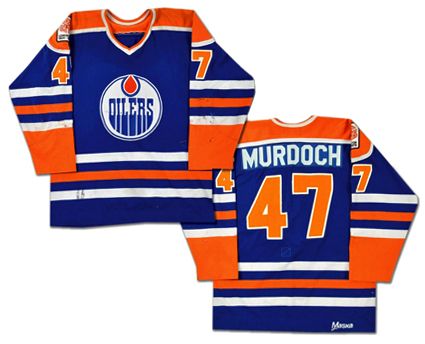
photo courtesy of Classic Auctions
That standout performance saw him drafted 12th overall by the Cincinnati Stingers of the WHA and 6th overall by the New York Rangers in the 1976 NHL Amateur Draft.
He opted to sign with the Rangers and wasted little time making an impact, scoring a goal 8:11 into his first NHL game against the Minnesota North Stars when he scored on a power play from Ken Hodge and Phil Esposito. He would add a second goal, again on the power play, at 14:28 of the second period from Esposito and Rod Gilbert. Two nights later Murdoch would score his third goal of the young season on October 8th from Gilbert and Carol Vadnais, yet again on a power play.
Murdoch wasted little time scoring his first NHL goal
After being held scoreless on October 9th against St. Louis, Murdoch took to the ice for just his fourth NHL game on this date in 1976 against Minnesota once again. Despite the teams trading six goals in the first period, 4 by the Rangers and 2 for Minnesota, Murdoch was held off the scoresheet despite three Rangers power play opportunities.
Both the North Stars Gary Smith and the Rangers Gilles Gratton seemed to have settled down after the wild first period as neither team was able to score for the first eight minutes of the second period, the longest scoreless stretch of the game so far, until Murdoch beat Gratton at 8:23 for his fourth goal of the season and his first at even strength from Dan Newman and Pete Stemkowski. The North Stars responded with a pair of goals at 9:46 and 11:31 to make the score 5-4 for New York, but exactly one minute later, Murdoch struck again at 12:31 from Walt Tkaczuk and Greg Polis to extend the Rangers advantage back to two. With Minnesota's Tim Young in the penalty box, Murdoch completed his hat trick with his third goal of the period and sixth of his career in just his fourth game when he beat Smith with just ten seconds remaining in the second period from Vadnais and Hodge.
After Gilbert put New York ahead 8-4 at 11:28, Murdoch did it again, scoring his fourth goal of the night from Tkaczuk and Polis at 17:32. Finally, with just five seconds left in the game, Murdoch earned a spot in NHL history when he scored his fifth goal of the game, this one unassisted, to become only the second rookie in NHL history after Howie Meeker in 1947 to score 5 goals as a rookie, although it took Meeker until January 8, making Murdoch easily the quickest to do so from the start of his career - just four games! Murdoch was the 22nd player in the then 60 year history of the NHL to score five goals in a game and the first rookie in 30 years to accomplish the feat.
"I'll tell you, something like that you never forget," Murdoch recalled. "It was one of those nights that everything I touched went in. It was something else. I can remember the fifth goal. We were up 9-4 and we had a power play. [Head Coach John Ferguson] says 'Put the kid out again.' and we went out on a draw. Esposito was my centerman and Phil told me to stand right there. There was a12 seconds left and the faceoff was in Minnesota's end and he said; 'Don't move, I will get you the puck.' And sure as heck, Phil got the puck to me adn I slapped it in the bottom corner for the fifth goal. It was really crazy, especially being in New York. It took off really wild. I had three goals in the other games and everywhere I went, all the reporters were flocking to find out who is this unknown guy. I had no idea at all it would be that quick."
Murdoch became only the second rookie to ever score 5 goals in an NHL game, doing so in just his fourth game as a professional
Murdoch would go on to score 15 goals in his first 15 games and eventually score 32 goals and 56 points that season (both Rangers rookie records) before a season ending torn Achilles tendon in February ended his season after just 59 games. He finished fourth in team scoring behind Esposito, Gilbert and Hodge as a rookie, while his nearly point per game average was level with Esposito and Gilbert and would have seen him challenging for the team points lead had he maintained that average over all 80 games.
The shine was taken off his stellar rookie season when he was arrested during the offseason by customs agents in Toronto with 4.5 grams of cocaine in his socks.
Still, he returned for the 1977-78 season, playing in 66 games, scoring 27 goals and 55 points, falling just one short of his rookie point total thanks to two ankle surgeries, a slipped disc in his back and a shoulder injury. His arrest came back to haunt him, as he was suspended by the NHL for the entire 1978-79 season after pleading guilty to the drug possession charges, which was later reduced to 40 games on appeal, which allowed Murdoch to play half the season, during which he scored 15 goals and 36 points. New York went on a lengthy playoff run, which gave Murdoch a chance to play in an additional 18 games, scoring an additional 7 goals and 12 points to place fourth in Rangers playoff scoring as they eventually lost in the Stanley Cup Finals.
During the 1979-80 season, he would score 23 goals and 42 points in 56 games for New York before being traded in March to the Edmonton Oilers for Cam Connor and a third round draft pick. In 10 games with Edmonton, Murdoch added another 5 goals and 7 points to set a new a career high with 59 points.
Murdoch became a member of the Oilers during their first NHL season
The 1980-81 season saw Murdoch lose his place in the NHL, playing 40 games with the Oilers, scoring 10 goals and 19 points before being sent down to the Wichita Wind of the Central Hockey League. After 25 points in 22 regular season games, he finished third on the team in playoff scoring with 17 goals and 24 points in 18 games as Wichita lost in the league finals.
Murdoch played two seasons with Edmonton
For the 1981-82 season, Murdoch's rights were dealt to the Detroit Red Wings. He played 49 NHL games with Detroit, but his scoring touch was fading, as he managed just 9 goals. He would also play in 24 games with their top minor league affiliate, the Adirondack Red Wings of the American Hockey League, scoring 24 points.
His 49 games with Detroit would prove to be his last in the NHL, as he split his time between Adirondack of the AHL (35 games) and the Montana Magic of the CHL (17) with a combined 36 goals and 66 points in 76 games in 1983-84.
Murdoch would play for the Muskegon Lumberjacks in 1984-85, but only saw action in just 32 games while scoring his customary point per game average with 31 points in 32 games.
The final season of his playing career came in 1985-86, as he played for Muskegon (12 games), the Indianapolis Checkers (11) and the Toledo Goaldiggers (37) before retiring as a player.
Murdoch's final NHL totals were 121 goals and 116 assists for 237 points in 320 games over the course of just six seasons despite the impressive start to his rookie season which held the promise of so much more. It proved to be too much too soon in the heart of Manhattan, where his sudden stardom led to his drinking habit becoming a drug problem. After Murdoch scored five goals in a game as an NHL rookie in 1976, no other rookie has duplicated his feat in now 41 seasons.
Today's featured jersey is a 1980-81 Wichita Wind Don Murdoch jersey as worn by Murdoch during his first stint in the minor leagues as his once so promising career began to unravel.
Wichita's first season of play was the 1980-81 season and they made it all the way to Game 7 of the CHL Finals. The franchise lasted only three seasons, two of which were as the Oilers affiliate and their final season in cooperation with the New Jersey Devils.
Bonus jersey: Today's bonus jersey is a 1979-80 Edmonton Oilers Don Murdoch jersey as worn during the Oilers first season in the NHL. Prior to joining the NHL, the lettering of the Oilers jerseys was a lower contrast orange on white, changing to a much more visible blue for their arrival in the NHL.

photo courtesy of Classic Auctions
Today's video section features an interview with Murdoch during the playoffs during the 1978 playoffs as well as some game action showing the Rangers short lived modern jerseys, worn only two seasons.
Labels:
Edmonton Oilers,
Murdoch Don,
Wichita Wind
Tuesday, October 11, 2016
1924-25 Boston Bruins George Redding Jersey
On this date in 1924, the Boston Bruins officially received their NHL franchise, which made them the first club in the league located in the United States and, with the addition of the Montreal Maroons, brought the NHL up to six member clubs.
Charles Adams was taken by professional hockey after having attended the 1924 Stanley Cup Finals between the NHL's Montreal Canadiens and the Calgary Tigers of the WCHL.
His first order of business was to hire Art Ross as his new club's general manager, a post he would remain in for 30 years. It was Ross who coined the name "Bruins" after being challenged by Adams to come up with a name for the franchise of an animal that would represent speed, agility and cunning, while the club's original colors of brown and yellow were taken from Adams grocery store chain, First National Stores.
The Bruins played their first game on December 1, 1924 against their fellow expansion brothers that season, the Maroons, with the Bruins prevailing 2-1. The opening night victory flattered to deceive, as the Bruins would win just five more games that season on their way to a last place finish and a 6-24-0 record. Jimmy Herberts led the team in scoring by a wide margin, with is 17 goals in 30 games accounting for 35% of the Bruins 49 goals that season. His 22 points far outdistanced the next player who managed a paltry 8!
The Bruins began life in the Boston Arena for the first four years of their existence prior to moving into their long time home, the Boston Garden, while the Boston Arena would become the property of Northeastern University and, while renamed the Matthews Arena in 1982, it remains the oldest surviving indoor ice arena still in use in the world. While the Bruins moved out in 1928, professional hockey would return in 1972 with the arrival of the New England Whalers of the upstart World Hockey Association for games during their inaugural season prior to moving to Hartford, Connecticut.
The Bruins improved during their second season 0f 1925-26 in the now seven team NHL, but still finished outside the playoffs by but a single point despite their winning record of 17-15-4. Carson Cooper, with 28 goals, and Herberts, with 26, tied for the team scoring lead of 31 points.
1925-26 Boston Bruins
In 1926-27, the NHL divided itself into two divisions, with the Bruins in the new "American" division, with their success having opened the floodgates of the United States market with teams now in New York, with both the Rangers and Americans, Chicago, Pittsburgh and Detroit. The Bruins came second in the division behind the Rangers with a 21-20-3 record, led by Harry Oliver's 18 goals and 24 points. A new arrival to the Bruins roster would come in the from of the legendary Eddie Shore, a rough and tough future Hall of Famer who would play for the club until 1940.
1926-27 Boston Bruins
In the playoffs for the first time, the Bruins would defeat the Chicago Black Hawks 6-1 and 4-4 to win their two-game, total-goal series 10-5. Playing the same format, they would eliminate the Rangers after a scoreless tie in Boston with a 3-1 win on the road in New York to advance to the Stanley Cup Finals, the first contested by two NHL clubs.
The finals were a best-of-five versus the Ottawa Senators, however the first game was played to a scoreless tie. Ottawa won 3-1 before another tie, this time 1-1. Ottawa wrapped up the championship with another 3-1 win, taking the best-of-five by the unusual margin of 2-0-2.
The Bruins captured their first division title in 1927-28 with 20 wins, 13 losses and 11 ties as Oliver again led the club in scoring with 18 points, one more than defenseman Shore's 17. Another legendary Bruin Dit Clapper would join the club that season and remain with the Bruins for 20 years. The Rangers got their revenge and knocked the Bruins out of the playoffs with a 1-1 draw and a 4-1 win in Boston.
The Bruins again won the American Division in 1928-29 with a 26-13-5 record which included going undefeated for all of January (11-0-2). Oliver remained in his familiar place atop the scoring table with 17 goals and 23 points in 43 games.
Their division title earned them a first round bye in the playoffs. Tiny Thompson in goal shut out the Montreal Canadiens 1-0 and again 1-0 in the first two games and the Bruins closed out the series with a 3-2 win.
Awaiting them in the finals were the Rangers, and the Bruins dispatched them with a 2-0 win at home followed by a 2-1 win in New York to win the first Stanley Cup in franchise history as they became the last team until 1952 to sweep all their playoff games.
The Stanley Cup Champion 1928-29 Boston Bruins
The Bruins would return to the finals the following season but come up short. They would win Stanley Cups again in 1939 and 1941, but then suffer a drought which would last 29 years, including a dismal run where they would miss the playoffs eight consecutive seasons beginning in 1960 and finish last six out of seven seasons from 1961 to 1967, making their championship just three seasons later in 1970 all the more remarkable.
Today's featured jersey is a 1924-25 Boston Bruins George Redding jersey from the Bruins very first season. This jersey style was used for only one season and sold at auction for $27,000 in April, 2009. It is believed to be the only surviving jersey from the Bruins inaugural season, making it a truly unique item and an incredibly significant piece of memorabilia from such a historic franchise and one of the most exciting jerseys we have ever featured here at Third String Goalie.
Redding, a defenseman, would play 35 games for the Bruins over their first two seasons, scoring 3 goals and 2 assists, all in 1924-25, and would play six more seasons of hockey in lower leagues, making stops in Boston, London, Ontario, Minneapolis and Buffalo.
Our video section today is a look back at the history of the Boston Bruins franchise.
Labels:
Boston Bruins
Monday, October 10, 2016
Columbus Day - 2005-06 Columbus Blue Jackets Rick Nash Jersey
Christopher Columbus left on his first voyage of exploration seeking a westerly route to southeast Asia on August 3, 1492 from Spain with three ships, the Niña, the Pinta and the Santa Maria, on a voyage which would first take him to the Canary Islands off the northwest coast of Africa for supplies and repairs. This was followed by a five week voyage across the Atlantic Ocean, arriving in what is now The Bahamas near Florida and Cuba on October 12, 1492. In the United States, Columbus Day is now celebrated on the second Monday in October.
Columbus continued to explore the region through the middle of January before returning to first Portugal and then Spain, having believed he had been in the East Indies off of southeast Asia the entire time, having both underestimated the size of the Earth and overestimated the size of Asia, partly due to different systems of measurement in use during his time, despite scholars having calculated the size of Earth as far back as 300 BC, 1800 years earlier,
He returned to colonize the region during his second voyage in late 1493, still believing that Cuba was a peninsula of the Asian continent, and made his third trip in 1498, which included his first stop on the mainland of South America. His fourth and final voyage took place in 1502, which included extensive exploration of the east coast of southern Central America. With his ships battered by storms and attacks by the natives, Columbus and his men were eventually stranded on Jamaica for a year before aid eventually arrive. He and his crew were finally able to return to Spain where he died on May 20, 1506 at the estimated age of 54.
While the North and South American continents were eventually named after Italian Amerigo Vespucci, Columbus was honored as a founding figure of the New World and many places were named either "Columbia" or "Columbus" in his honor following the American Revolution in the 1770's, including the District of Columbia, Columbia, the capital city of South Carolina, and the capital of Ohio, Columbus, which is now home to the Columbus Blue Jackets of the NHL.
Columbus Day became a federal holiday in the United States in 1937 in part due to the efforts of the fraternal organization the Knights of Columbus, although Columbus' arrival has been celebrated dating back to colonial times. It's particularly popular among Italian-Americans who see it as a celebration of their heritage, which dates back to 1866 in New York City.
In recent times, opposition has arisen to Columbus Day, as Columbus has come under not only criticism for his treatment of the indigenous people he personally encountered, but also due to his becoming symbolic of the devastating diseases brought to the New World by the Europeans and the treatment and genocide of the local populations by the Europeans who colonized the American continents following his arrival, despite Columbus never having stepped foot on the North American mainland.
Christopher Columbus
Columbus continued to explore the region through the middle of January before returning to first Portugal and then Spain, having believed he had been in the East Indies off of southeast Asia the entire time, having both underestimated the size of the Earth and overestimated the size of Asia, partly due to different systems of measurement in use during his time, despite scholars having calculated the size of Earth as far back as 300 BC, 1800 years earlier,
The world as it was known in the time of Columbus.
The land mass in the lower left is Antarctica.
He returned to colonize the region during his second voyage in late 1493, still believing that Cuba was a peninsula of the Asian continent, and made his third trip in 1498, which included his first stop on the mainland of South America. His fourth and final voyage took place in 1502, which included extensive exploration of the east coast of southern Central America. With his ships battered by storms and attacks by the natives, Columbus and his men were eventually stranded on Jamaica for a year before aid eventually arrive. He and his crew were finally able to return to Spain where he died on May 20, 1506 at the estimated age of 54.
While the North and South American continents were eventually named after Italian Amerigo Vespucci, Columbus was honored as a founding figure of the New World and many places were named either "Columbia" or "Columbus" in his honor following the American Revolution in the 1770's, including the District of Columbia, Columbia, the capital city of South Carolina, and the capital of Ohio, Columbus, which is now home to the Columbus Blue Jackets of the NHL.
Columbus Day became a federal holiday in the United States in 1937 in part due to the efforts of the fraternal organization the Knights of Columbus, although Columbus' arrival has been celebrated dating back to colonial times. It's particularly popular among Italian-Americans who see it as a celebration of their heritage, which dates back to 1866 in New York City.
The New York City Columbus Day Parade
In recent times, opposition has arisen to Columbus Day, as Columbus has come under not only criticism for his treatment of the indigenous people he personally encountered, but also due to his becoming symbolic of the devastating diseases brought to the New World by the Europeans and the treatment and genocide of the local populations by the Europeans who colonized the American continents following his arrival, despite Columbus never having stepped foot on the North American mainland.
The Columbus NHL franchise, founded in 2000, selected the name "Blue Jackets", a nickname for the Union soldiers in the Civil War, to honor the contributions made by the state of Ohio during the war, which included Ohio contributing more of it's population to the Union Army than any other state and the fact that many of the Union uniforms were manufactured in Columbus.
Life for the Blue Jackets in the NHL has been a rough go, as they finished last in the Central Division in each of it's first three seasons and averaging only 69 points in it's first seven seasons, missing the playoffs each time out.
After a 92 point season in 2008-09, the Blue Jackets made the playoffs for the first time in franchise history, only to be swept in four games by the Detroit Red Wings. That glimmer of hope was subsequently dashed as the franchise sank back to the depths of last place with 65 points in 2011-12, which was then followed by losing the draft lottery and missing out on the first overall pick in 2012.
They narrowly missed the playoffs in the lockout shortened 2012-13 season and set a franchise record with 93 points in 2013-14 after going 43-32-0-5. They drew the Pittsburgh Penguins in the first round and won their first playoff game in franchise history when they won Game 2 in overtime 4-3 on the road. They also won Game 4 at home by the same score of 4-3, again in overtime but lost the series in six games.
In 2014-15 they nearly duplicated their record, going 42-35-3-2, but the drop to 89 points left them well short of the 97 needed to make the postseason. Last year the Blue Jackets fell to 76 points and missed the playoffs for the 13th time in their 15th years.
They narrowly missed the playoffs in the lockout shortened 2012-13 season and set a franchise record with 93 points in 2013-14 after going 43-32-0-5. They drew the Pittsburgh Penguins in the first round and won their first playoff game in franchise history when they won Game 2 in overtime 4-3 on the road. They also won Game 4 at home by the same score of 4-3, again in overtime but lost the series in six games.
In 2014-15 they nearly duplicated their record, going 42-35-3-2, but the drop to 89 points left them well short of the 97 needed to make the postseason. Last year the Blue Jackets fell to 76 points and missed the playoffs for the 13th time in their 15th years.
The franchise's all-time leading scorer by far is Rick Nash, who arrived in time for the 2002-03 season after being drafted #1 overall in the 2002 Entry Draft. His 547 points are currently 230 more than David Vyborny and 347 more than third place R. J. Umberger's 200! Nash tied for the league lead in goals with 41 during the 2003-04 season, earning a share of the Rocket Richard Trophy. Goaltender Steve Mason earned the Calder Memorial Trophy for his stellar debut season in 2008-09. Sergei Bobrovsky won the third major NHL award for the franchise when he took home the Vezina Trophy in 2012-13 as the league's top goaltender.
The former face of the Blue Jackets franchise, Rick Nash
Today's featured jersey is a 2005-06 Columbus Blue Jackets Rick Nash jersey. This very well received alternate jersey was worn by the franchise all time leading scorer for three seasons from 2003-04 to 2006-07 (the 2004-05 NHL season was not played due to labor issues), only being discontinued due to the change to the new Reebok Edge jerseys the following season, which led to a suspension of all third jerseys for 2007-08.
Bonus jersey: Today's bonus jersey is a 2000-01 Columbus Blue Jackets Lyle Odelein jersey. It features the Blue Jackets Inaugural Season patch, as well as one of our custom made Hockey Fights Cancer patches. Odelein was selected by the Blue Jackets in the 2000 expansion draft and later named the first captain of the franchise.
Bonus jersey: Today's bonus jersey is a 2000-01 Columbus Blue Jackets Lyle Odelein jersey. It features the Blue Jackets Inaugural Season patch, as well as one of our custom made Hockey Fights Cancer patches. Odelein was selected by the Blue Jackets in the 2000 expansion draft and later named the first captain of the franchise.
The Hockey Fights Cancer patch was first worn by the captain of each team for one game only in January of 2001. The patches from 2001 do not carry the date, as they did in the subsequent three years of the program. Each specially patched game worn jersey would then be auctioned off for charity as part of the festivities at that year's NHL All-Star Game to raise money for cancer research.
Today's video section begins with highlights of the Columbus Blue Jackets in action.
Labels:
Columbus Blue Jackets,
Nash Rick,
Odelein Lyle
Subscribe to:
Comments (Atom)

